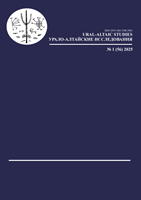Комитативные конструкции с единицами tāɣəl ‘полнота’ и lūt ‘все прочее’ в северномансийском языке
Comitative constructions with tāɣəl ‘fullness’ and lūt ‘other things’ in Northern Mans
Author(s): Irina A. Khomchenkova, Daria O. ZhornikSubject(s): Morphology, Lexis, Historical Linguistics
Published by: Институт языкознания Российской академии наук
Keywords: comitative; universal quantification; similative plural; general extenders; Mansi; Ob-Ugric; Finno-Ugric;
Summary/Abstract: In Northern Mansi, there are a number of markers used in comitative constructions (ComC). The basic comitative marker is the postposition jot — it is used in the genuine ComC (John went into the forest with Peter), as well as in the ComC with polyadic predicates (John is fighting with Peter), the coordinating ComC (Ivan with Petya are leaving, which is ungrammatical in English), the inclusory ComC (We left with Ivan (together), which is also ungrammatical in English) and in some idiolects in the depictive ComC (Ivan went into the forest with a gun). In the coordinating and inclusory constructions, the instrumental case marker -(ə)l / -t(əl) is also possible. It is commonly used with the dual possessive marker, which refers to both NPs. In this paper we consider two more (peripheral) markers: tāγəl ‘fullness’ and lūt ‘other things’, which is a general extender / a marker of similative plurality. The first one is used in the depictive ComC; a proprietive marker is attached to the noun in this case. The second one can be used in the depictive ComC either together with tāγəl or in the instrumental form. We show that jot does not impose any restrictions on the referent of the comitative NP, while tāγəl and lūt are typical in so-called “holistic” comitative contexts, where two objects form a single whole in a situation (for example, to throw away a closet along with clothes). We argue that in this case lūt serves as an intensifier, which is noted for general extenders in other languages.
Journal: Урало-алтайские исследования
- Issue Year: 2025
- Issue No: 01 (56)
- Page Range: 94-117
- Page Count: 24
- Language: Russian

